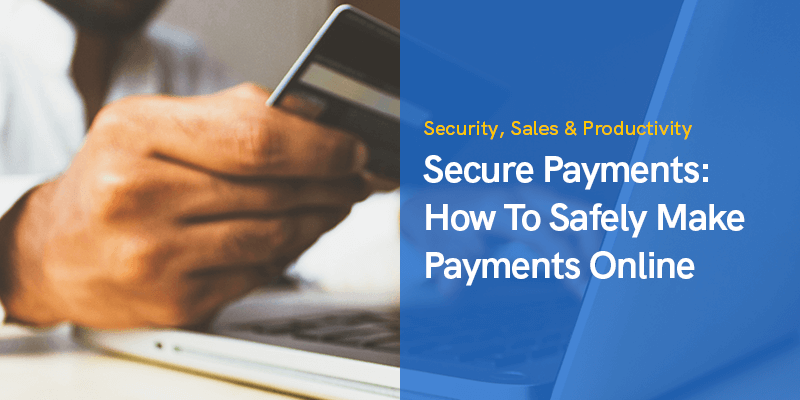
Secure Payments: How To Safely Make Payments Online in 2023
There is nothing more seamless than taking payment online – let alone the hassle of carrying cash, the burden of change, and possibly theft too.
Agreed! But remember, where there are perks, there are cons also.
The risks linked with paying online are high, and you must practice safety precautions to steer away from traps you could fall into.
Note that the new generation's hungry customer lacks patience and does not lack the variety and options around.
It would not take a consumer more than a second to switch if met with incoherencies.
About 58% of the consumers blame it on the security concerns if they see a payment failure or takes too much time to process.
Hence, it is no surprise that securing your payments is an excellent way to show customers your honesty and trademark your authenticity.
To achieve that trust of the consumers, you will have to take up specific compliance requirements that serve the purpose.
Today, this post will run you through the need to get an SSL Certificate, EV SSL Certificate, and why PCI Compliance will save you a fortune.
How to Safely Make Payments Online
Here is what we will be digging into today:
- What is an SSL Certificate?
- What does the SSL Certificate validate?
- What are the steps to the SSL Process?
- How to take Payments?
- What is an EV SSL Certificate?
- What is PCI Compliance?
- Ways of achieving PCI Compliance
- Why should you become PCI Compliant?
What Do You Understand About an SSL Certificate?
SSL stands for a secure socket layer and is a measure of standard security technology that establishes a safe link between a user's web server and a website.
It is the job of an SSL to ensure that all the communications that take place within are entirely encrypted and safe from the clutches of a hacker.
And on similar tracks, an SSL Certificate is a digital certificate that puts the website's identity in a rather authenticated format and then encrypts this information sent from the site to the webserver guarded by the SSL security technology.
Further, this certificate will validate your site with an HTTPS URL instead of an HTTP.
The extra ‘S’ denotes the users that your site is verified.
What Does the SSL Certificate Validate?
These certificates are highly useful in verifying your domain and your identity.
Note that a certificate validated by the domain will render your users with umpteen assurance and trust.
This is exactly what they look for when they browse your site.
It is effortless these days to forge a fake signature for free.
However, the browsers only trust those certificates that originate from a validated SSL Certificate issuer, which is also known as CA (Certificate Authority).
Understanding the SSL Process
- To begin with, the browser initiates a connection to a fully secured website.
- This is then followed by the server that tries to share a copy of its public keys and SSL Certificate.
- Once this is cleared, the browser authenticates and validates the provided certificate.
- If the certificate turns out to be trustable, then the browser goes ahead with it and reverts with a session key to the server.
- This is done by using the server’s public key.
- Once the server validates and accepts this recognition, it then entrusts the issuer with the certificate.
- In technical terms, this is referred to as ‘SSL Handshake.’ This marks the beginning of a secured session that privately protects the message integrity and stops it from getting hacked at any cost.
- And finally, the server and the browser can now share the encrypted and validated data over the safeguarded medium.
How to Take Payments?
It is always advised to use a trusted provider for accepting payments.
Additionally, you may receive the payments through renowned brands like GoCardless or PayPal as well or PayFasto if you need a merchant account provider for your high risk business
You can learn all about merchant accounts in this great blog post from PaymentCloud.
With the help of a displayed brand name, the consumer gains trust in you and will most likely revert to do more business with you due to the enhanced trust quotient.
Before you start accepting the money, get yourself an SSL Certificate having the highest level of security.
Now, this may require you to spend a couple of dollars.
At the same time, you will find many such providers regaling you with an eclectic range and levels of certificates.
You might be wondering about buying the most expensive one that will offer you the best facilities.
Though it could be true in some cases, it is not necessarily always right.
That is where the EV SSL Certificate comes into play.
What Is Meant by An EV SSL Certificate?
EV is an abbreviation for extended validation.
This is seen as an indicator of trust and activates the HTTPS URL.
The added expenditure and the time spent behind it make it truly difficult to become prey to phishing and hacking.
EV SSL Certificate can also be used in high profile websites, major brands, financial institutions, and banks.
Spending a little extra will not cut a massive hole in your pocket too.
And while it comes at the cost of enhanced security, you must get one of these and bid goodbyes to the inadvertent issues, troubles, and tension.
Install one today itself.
What Is PCI Compliance?
PCI Compliance plays a pivotal role when it comes to taking online payments.
Each business owner – be it from multi-thousand dollars organizations to small internet stores – all of them who accept credit card payments (whether online or offline), must comply with the PCI DSS (Payment Card Industry Data Security Standard).
The PCI DSS denotes the framework of the twelve technical requirements that have been set by the standard for storing, processing, and transferring private information like card details and transaction credentials.
Ways of Achieving PCI Compliance
To get scanned for PCI compliance, first and foremost, it will be checked that you are an entitled organization accepting valid payments online.
You will not require a scan of your website if you have never transacted a financial settlement with a company or a consumer.
Further, the second point that needs to be checked is that the financial information is entered on, passed through, and stored on your site.
Failing to do so will not make you eligible for being PCI compliant.
Why Should You Become PCI Compliant?
Now you may have a ton of questions related to PCI, especially if you are from a small to medium-scale industry.
And on similar grounds, you may feel insecure and gather a ton of confusions around the topic.
Although it might seem frustrating at first, it gives you all the more reason to get it done before it is too late.
For starters, being PCI compliant shows that your systems are secured and safeguarded.
Further, your users can transact any amount of financial activity without having to worry about hacks or any other cybercriminal activities.
This prevents security breaches and theft of payment card data as well.
Also, note that if this is ignored, it can easily lead you to lawsuits, vehement fines, canceled accounts, loss of reputation, and eviction out of business as well.
Therefore, before it is too late, you must get yourself the prestigious tag of being PCI compliant.
That’s a Wrap
It is no wonder that our shopping habits have immensely changed over the years.
And the consumer today wants to surface themselves to these changes as fast as possible.
It is left to be seen whether these changes amplify with time or will it remain as such.
However, the world of e-commerce has undoubtedly given us many options and benefits.
It sure has paved the way for cybercriminal activities to flourish as well.
Being a merchant, you will have to do whatever it takes to ensure that the user who comes to your site does not go dissatisfied and unhappy.
The burden of responsibility is on your shoulder to show the customer that you genuinely care and are serious about your business schemes.
Make it a point that you implement sound, preventive and proactive measures about cybersecurity rather than waiting for a hurricane to hit you hard, and even before you know it, all your data could vanish.
I hope this blog gave you some details about protecting your site and your customers from the clutches of the cyberattacks that take place while accepting payment online.
Recommended Posts

Top 6 Free Windows Screen Recorders for Your Personal Blog
February 8, 2024

Marketing Tactics for WordPress Excellence in 2024
January 22, 2024


